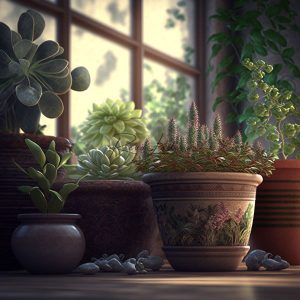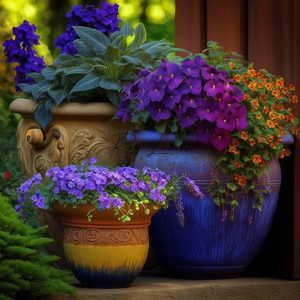Container gardening is a popular and versatile method of growing plants in small spaces. It allows individuals to have a garden even if they have limited outdoor space or live in an apartment or condominium. Container gardening also provides a way to grow plants that may not thrive in a particular soil or climate. In this article, we will cover the essentials of container gardening, including selecting containers, soil and fertilizers, and choosing the right plants.
Selecting Containers
 The first step in container gardening is selecting the right container. Containers can be made of various materials such as terra cotta, plastic, metal, or wood. It is important to choose a container that is the appropriate size for the plant you have chosen and has drainage holes to allow excess water to escape. Terra cotta pots are porous and can dry out quickly, whereas plastic pots retain moisture longer. It is also important to consider the weight of the container when it is filled with soil and plants. A container that is too heavy can be difficult to move around.
The first step in container gardening is selecting the right container. Containers can be made of various materials such as terra cotta, plastic, metal, or wood. It is important to choose a container that is the appropriate size for the plant you have chosen and has drainage holes to allow excess water to escape. Terra cotta pots are porous and can dry out quickly, whereas plastic pots retain moisture longer. It is also important to consider the weight of the container when it is filled with soil and plants. A container that is too heavy can be difficult to move around.
Soil and Fertilizer
The next step is to select the right soil and fertilizer for your plants. Container gardening requires a special type of potting soil that is designed to provide the right drainage, aeration, and moisture retention for container-grown plants. A good potting soil should be lightweight, well-draining and free of weed seeds and disease organisms. Fertilizer is also important to ensure that your plants have the necessary nutrients to grow and thrive. A slow-release fertilizer is a good option for container gardening as it releases nutrients over a longer period of time.
Choosing the Right Plants

When selecting plants for container gardening, it is important to choose plants that are well-suited to the climate and light conditions of your area. Some plants, such as succulents and cacti, are well-suited to dry, sunny conditions, whereas others, such as ferns and impatiens, prefer a more shaded location. It is also important to choose plants that will not outgrow their container. A general rule of thumb is to choose plants that will not grow taller than twice the height of the container.
Tips and Tricks
- Consider using a saucer or tray under the container to catch water and protect surfaces from water damage.
- Keep an eye on the moisture level of the soil, as container gardens dry out more quickly than in-ground gardens.
- Experiment with different combinations of plants to find the perfect mix for your container garden.
In conclusion, container gardening is an easy and accessible way to bring the beauty of plants into your home or small space. By following the essentials outlined in this article, you can create a thriving container garden that will provide you with fresh herbs, flowers, and vegetables.


